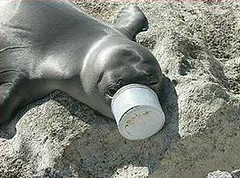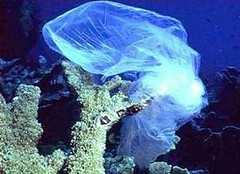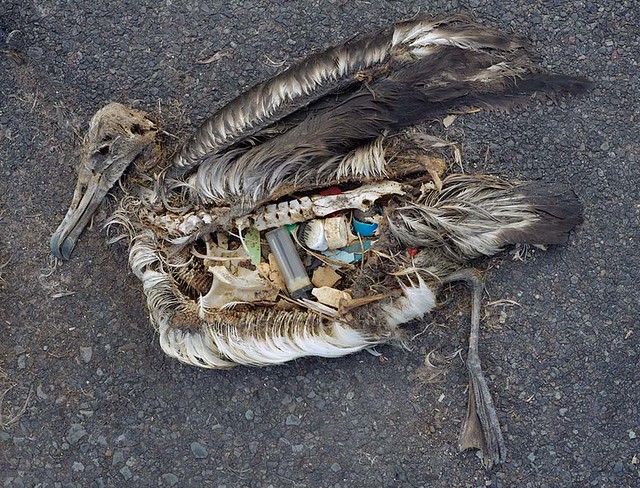 美國民間團體「生物多樣性中心」22日向聯邦環保署提交請願書,要求環保署依照《淨水法》(Clean Water Act)設立海洋塑膠垃圾污染管制標準。
美國民間團體「生物多樣性中心」22日向聯邦環保署提交請願書,要求環保署依照《淨水法》(Clean Water Act)設立海洋塑膠垃圾污染管制標準。
這份請願書訴求抑制海洋塑膠污染,因為每年有數十萬隻海鳥、許多瀕臨絕種的海龜及僧海豹均受害。
生物多樣性中心正式請求環保署開始制訂國家水質標準,找出塑膠污染的證據並發布資訊供各州檢視,以防治塑膠污染的毒害。
這份請願書要求,完全去除可見的海洋塑膠垃圾,並嚴格限制海中或沙灘上的塑膠顆粒容許值。
「塑膠製品對我們日常生活非常便利,對海鳥、海豹、海龜以及數百種海洋生物卻是的殘酷死亡陷阱。」生物多樣性中心律師Emily Jeffers表示,「我們的海洋被塑膠袋、瓶蓋、寶特瓶、糖果包裝紙弄得凌亂不堪,該是環保署介入並解決這項危機的時候了。」
在《淨水法》規定之下,各州必須遵行環保署的水質標準,並標出未達標準的水域。加州及夏威夷都已採取行動管制塑膠垃圾,若聯邦能訂定國家標準,將可促使其他各州加入。
 生物多樣性中心表示,過去十年內所產生的塑膠比前一世紀還更多,且大部分最後都進入海洋;如今,世界大約40%的海洋被大型垃圾漩渦占據,其中包含上億磅的塑膠物。「就洛杉磯一個地區,每一天就有20噸的塑膠廢料像是塑膠袋、吸管、汽水瓶進入太平洋。」
生物多樣性中心表示,過去十年內所產生的塑膠比前一世紀還更多,且大部分最後都進入海洋;如今,世界大約40%的海洋被大型垃圾漩渦占據,其中包含上億磅的塑膠物。「就洛杉磯一個地區,每一天就有20噸的塑膠廢料像是塑膠袋、吸管、汽水瓶進入太平洋。」
這些塑膠垃圾大部分都會漂流至「太平洋垃圾帶」(Great Pacific Garbage Patch),一個大型海洋廢棄物聚集處,大小約276,263平方英里,比德州還要大。
生物多樣性中心在請願書中指出,「塑膠汙染是會產生有毒化學物的,而這些化學物質則會透過海洋食物鏈不斷累積。」
太平洋的魚每年吃掉一兩萬噸塑膠垃圾
在北太平洋的魚群每年吃進1.2萬至2.4萬噸的塑膠,導致腸道受傷以及死亡,吃下去的塑膠還藉由食物鏈間接到大魚或海洋哺乳動物的肚子,多樣性中心表示。
生物多樣性中心指出,海龜也誤食了許多漂浮塑膠袋。即便塑膠袋最常被誤食,赤蠵龜的胃內含物中還發現有軟塑膠、繩索、發泡膠及單絲魚線。「誤食塑膠可以導致腸道堵塞、潰瘍、器官穿孔及死亡。」
海洋哺乳動物也會誤食塑膠或是受塑膠廢棄物纏繞,塑膠垃圾(特別是打包帶)已經造成瀕危史代拉海獅的傷亡。2008年,兩隻在加州海岸發現的抹香鯨胃內含物中發現大量的廢魚網、塑膠繩及其他塑膠廢棄物。

一隻信天翁雛鳥屍體的胃內含物,包括了許多海洋塑膠垃圾。
照片由Chris Jordan攝於2009年9月攝於中途島環礁保護區。
每年數十萬隻海鳥誤食塑膠垃圾。這些塑膠會佔據牠們胃部空間,換言之牠們可以消化真正食物的空間越來越少,最終因此而餓死。
該中心提出海岸及底泥的水體(waterbody)塑膠含量量化標準:「包括高潮線以內的海岸,每平方公尺海洋底泥所含的塑膠應少於一個。」
在水柱(water column)塑膠含量量化標準方面,該中心建議的標準是每立方公尺內,塑膠應少於一個。
「這並不是件複雜的事,如果我們想要健全的海洋生態,我們需要將垃圾排除於海洋之外。如果這可成為國家的優先事項,我們可以讓這件事成真。我們希望這份請願能啟動程序。」Jeffers如此表示。
The Center for Biological Diversity filed a legal petition with the U.S. Environmental Protection Agency Wednesday that asks the agency to set plastic pollution limits for ocean waters under the Clean Water Act.
The petition seeks to curb plastic pollution in the oceans that kills and injures hundreds of thousands of seabirds as well as many endangered sea turtles and monk seals every year.
The Center for Biological Diversity formally requests that the EPA initiate a rulemaking to establish national water quality criteria to address plastic pollution, and publish information to guide states in monitoring and preventing harm to waters from plastic pollution.
The petition seeks criteria to limit visible plastic pollution in the oceans to zero and set strict limits on small plastic items in oceans and on beaches.
“Plastics are an everyday convenience for us but a daily death sentence for seabirds, seals, sea turtles and hundreds of other ocean species,” said Emily Jeffers, an attorney with the Center for Biological Diversity.
“Our oceans are littered with grocery bags, drink lids, water bottles and candy wrappers,” Jeffers said. “It’s time for the EPA to step in and finally address this crisis.”
Under the Clean Water Act, states must adopt water-quality standards recommended by the EPA and identify waters that do not attain those standards. California and Hawaii already have taken action to control plastic trash, and national plastic standards would cause other states to do the same.
More plastic has been produced in the past decade than over the past century and much of it ends up in the ocean, says the Center. Today, roughly 40 percent of the world’s oceans are covered in giant, swirling convergences of garbage, including billions of pounds of plastic.
“In the Los Angeles area alone, 20 tons of plastic fragments, such as grocery bags, straws and soda bottles, are carried into the Pacific Ocean every day,” the Center said Wednesday in the announcement of its petition.
Much of that plastic goes into the Great Pacific Garbage Patch, a mass of debris that spreads across 276,263 square miles, an area larger than the state of Texas.
“Plastic pollution is also known to attract and concentrate toxic chemicals. These chemicals can further accumulate as they pass up the marine food chain,” the Center explains in its petition.
Fish in the North Pacific ingest 12,000 to 24,000 tons of plastic each year, which can cause intestinal injury and death and transfers plastic up the food chain to bigger fish and marine mammals, the Center says.
Sea turtles also mistake floating plastic garbage for food. While plastic bags are the most commonly ingested item, loggerhead sea turtles have been found with soft plastic, ropes, styrofoam, and monofilament lines in their stomachs, the Center points out, saying, “Ingestion of plastic can lead to blockage in the gut, ulceration, internal perforation and death.”
Marine mammals ingest and get tangled in plastic. Entanglement in plastic debris, especially packing bands, has led to injury and death of endangered Steller sea lions.
In 2008 two sperm whales were found stranded along the California coast with large amounts of fishing net scraps, rope and other plastic debris in their stomachs.
Hundreds of thousands of seabirds ingest plastic every year. The plastic reduces the storage volume of their stomachs, meaning they consume less food and ultimately starve.
The Center proposes the adoption of a quantitative criterion for beaches and sediments that requires “less than one item of plastic per square meter for ocean sediments, including beaches at or below the high tide line” for a waterbody to attain plastic standards.
For plastic items in the water column, the Center proposes a criterion that waters should have “less than one item of plastic per cubic meter in the water column.”
”This isn’t rocket science,” Jeffers said. “If we want healthy sea life, we need to keep garbage out of our oceans. We can make it happen, but it’s got to become a national priority. We’re hoping this petition will jumpstart the process.”
※ 全文及圖片詳見 ENS





